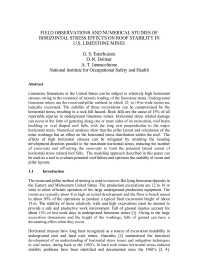Mining Publication: Field Observations and Numerical Studies of Horizontal Stress Effects on Roof Stability in U.S. Limestone Mines
Original creation date: March 2008
Limestone formations in the United States can be subject to relatively high horizontal stresses owing to the existence of tectonic loading of the limestone strata. Underground limestone mines use the room-and-pillar method, in which 12- to 18-m-wide rooms are typically excavated. The stability of these excavations can be compromised by the horizontal stress, resulting in a rock fall hazard. Rock falls are the cause of 15% of all reportable injuries in underground limestone mines. Horizontal stress related damage can occur in the form of guttering along one or more sides of an excavation, roof beam buckling or oval shaped roof falls, with the long axis perpendicular to the major horizontal stress. Numerical analyses show that the pillar layout and orientation of the mine workings has an effect on the horizontal stress distribution within the roof. The effects of high horizontal stresses can be mitigated by orienting the heading development direction parallel to the maximum horizontal stress, reducing the number of cross-cuts and off-setting the cross-cuts to limit the potential lateral extent of horizontal stress related roof falls. The modeling approach described in this paper can be used as a tool to evaluate potential roof failure and optimize the stability of room and pillar layouts.
Authors: GS Esterhuizen, DR Dolinar, AT Iannacchione
Conference Paper - March 2008
NIOSHTIC2 Number: 20033692
Proceedings of the 6th International Symposium on Ground Support in Mining and Civil Engineering Construction, Cape Town, Republic of South Africa, March 30-April 3, 2008. Johannesburg, Republic of South Africa: The South African Institute of Mining and Metallurgy, 2008; :103-118
See Also
- Computer Simulation of Ground Behaviour and Rock Bolt Interaction at Emerald Mine
- Controlling Roof Beam Failures From High Horizontal Stresses in Underground Stone Mines
- Effect of the Dip and Excavation Orientation on Roof Stability in Moderately Dipping Stone Mine Workings
- Field Observations and Numerical Studies of Horizontal Stress Effects on Roof Stability in U.S. Limestone Mines
- Pillar Stability Issues Based on a Survey of Pillar Performance in Underground Limestone Mines
- Roof Monitoring Helps Prevent Injuries in Stone Mines
- Roof Monitoring in Limestone - Experience with the Roof Monitoring Safety System (RMSS)
- Roof Span Design for Underground Stone Mines
- Technology News 481 - Update: Roof Monitoring Safety System for Underground Stone Mines
- Technology News 520 - A Method to Characterize Risk Associated With Mine Roof Conditions
- Page last reviewed: 9/21/2012
- Page last updated: 9/21/2012
- Content source: National Institute for Occupational Safety and Health, Mining Program


 ShareCompartir
ShareCompartir
